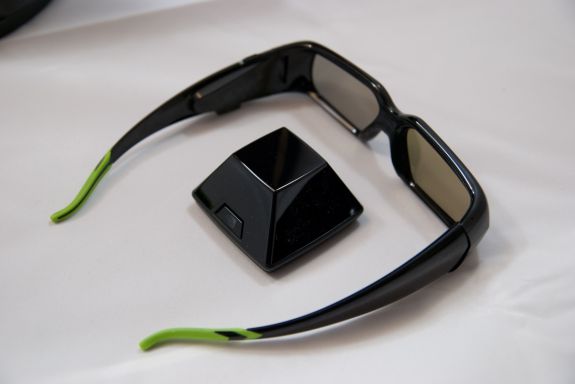ASUS VG236H 23-inch 3D Display Review: 120Hz is the Future
by Brian Klug on August 7, 2010 2:48 AM EST3D Vision on the VG236H
So let’s talk about 3D for a bit before going into the deep bits of the display’s performance. We’ve already covered NVIDIA’s 3D Vision here, but this review would just be incomplete without discussing how much I’ve changed my mind about 3D after playing with the VG236H.
First off, the NVIDIA 3D Vision kit itself is unchanged, though the packaging is a bit more compact. Inside is a soft cloth bag for the classes, two different nasal guides for comfort, two different length USB cables, the IR base station pyramid, shutter glasses, and demo and driver CDs. It feels like a high end product, with the base station pyramid and glasses sitting in foam cutouts, and the requisite accessories in a compartment above.
Additionally, you’ll need a 3D Vision compatible GPU, and can only drive 120Hz refresh rates over DVI-D, not HDMI. Because you’re rendering twice the frames (one for each eye), you’ll take a framerate hit for enabling 3D, so that GPU best be powerful. Zotac graciously supplied their ZOTAC GeForce GTX 470 for testing, which worked perfectly in my testbench.
I noted before that I’ve been skeptical about mainstream 3D gaming for some time now. I’ve seen my fair share of 3D content - though not as much as most of the other AnandTech writers that experienced it at CES on myriad displays - but have an above average grasp for the tech thanks to my optical sciences background.
That out of the way, most of the shutter or polarization based methods I’ve seen up until now suffered from being flickery. Refresh rate just wasn’t high enough, and the result was that I could detect individual frames when moving my head or really looking for it. In theaters, I tried the circularly polarized passive RealD system, and another IMAX 3D system using linear polarization. I had also tried a number of active LCD shutter systems on LCD TVs. While impressive, all of them had noticeable flicker.
The VG236H is the first 3D implementation I’ve played with that doesn’t have noticeable flicker. It just doesn’t. I was immediately impressed with the NVIDIA 3D Vision setup.
NVIDIA thankfully has a pretty comprehensive list of 3D Vision games and how good they perform with the whole system. At the top of the scale is 3D Vision Ready, meaning the game has basically been developed from the start to be viewed in 3D or 2D. Down the list is excellent, good, fair, poor, and not recommended. I first tried a number of ‘good’ titles, and found that while the 3D experience indeed worked, but often small things got in the way.













121 Comments
View All Comments
killerclick - Saturday, August 7, 2010 - link
Stop trying to push these stupid fads, I'm not buying 3D! Ever!Etern205 - Saturday, August 7, 2010 - link
3D monitors are just regular LCD screens which support up to 120Hz. Enabling 3D requires those special glasses and it's entirely up to you whether you want to enable it or not.There is not such thing as a 3D monitor as if there is, then you will need to wear the glasses every single time you use it.
And imo, that 3D logo on the stand looks hideous. Much like a ricer who puts sticker of tuners just to make it look cool or something.
Iketh - Saturday, August 7, 2010 - link
... but don't change the camera perspective when taking comparitive photos. The height adjustment images don't help a bit. Leave the camera in the same position for both.Etern205 - Saturday, August 7, 2010 - link
I thought all monitors are "3D" ?:P
smookyolo - Sunday, August 8, 2010 - link
That's what they'd like you to think, yes ;)dingetje - Sunday, August 8, 2010 - link
yes, and the old crt's are even more 3D than the new technology ;)HDPeeT - Saturday, August 7, 2010 - link
Thanks for the great review! I'm glad to see that there are professional sites out there that appreciate the advantages 120hz displays bring to the table besides just the 3D stuff.I know, I know, there are plenty of people out there that are really excited about 3D gaming and movies, but for me, it's all about the faster refresh and (hopefully) lower input lag.
The one thing I'm little confused about is how you reached the conclusion that the display has 3.9ms of lag. When you say "The VG236H consistently lags 1 frame from the FP241W.", wouldn't this imply that it has at least ~8ms of lag at a 120hz refresh (or even 16ms at 60hz (still not clear on that)?
Mumrik - Saturday, August 7, 2010 - link
Page 1: "On a technical level, the necessity for 120Hz arises from the need to drive two 60Hz images for each eye."That would take 240hz. You mean ONE 60Hz image for each eye.
cactusdog - Saturday, August 7, 2010 - link
Brian, Do you see the same benefits (of smoother motion on the desktop) when the VG236H is set to 60Hz?7Enigma - Monday, August 9, 2010 - link
Good question. The obvious answer is no, but I agree it should quickly be tested.